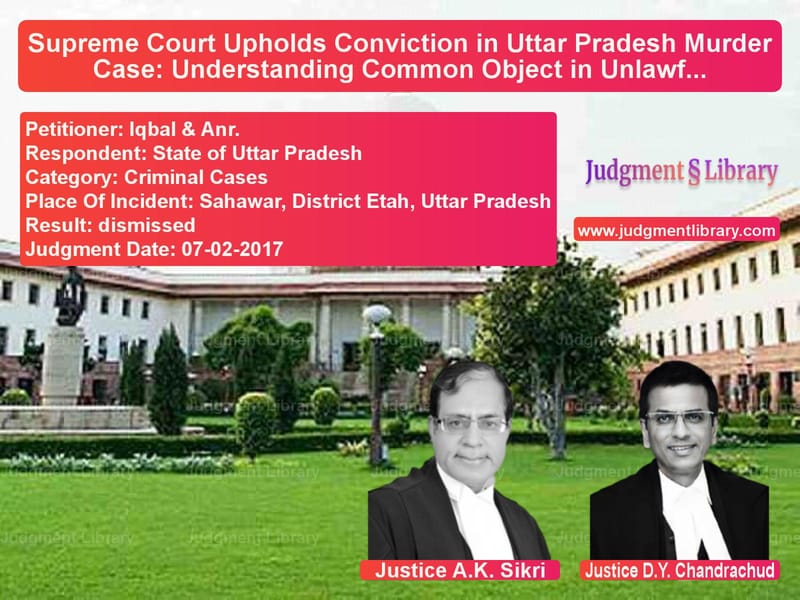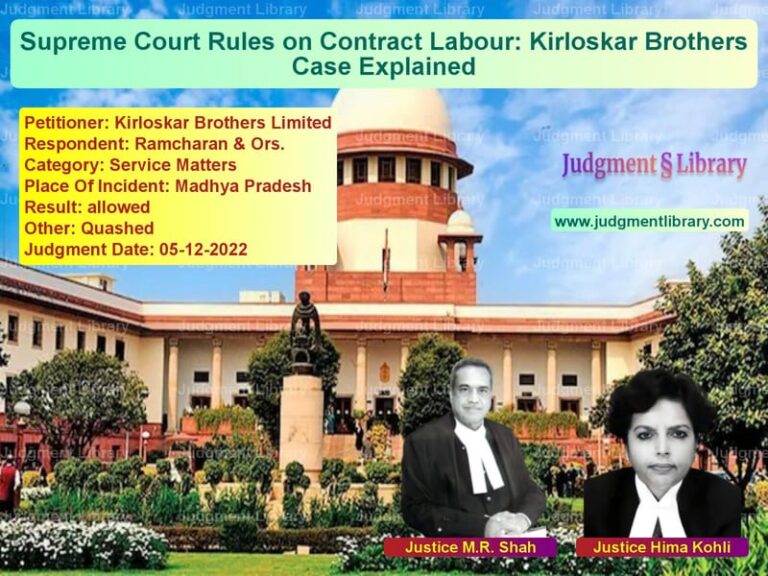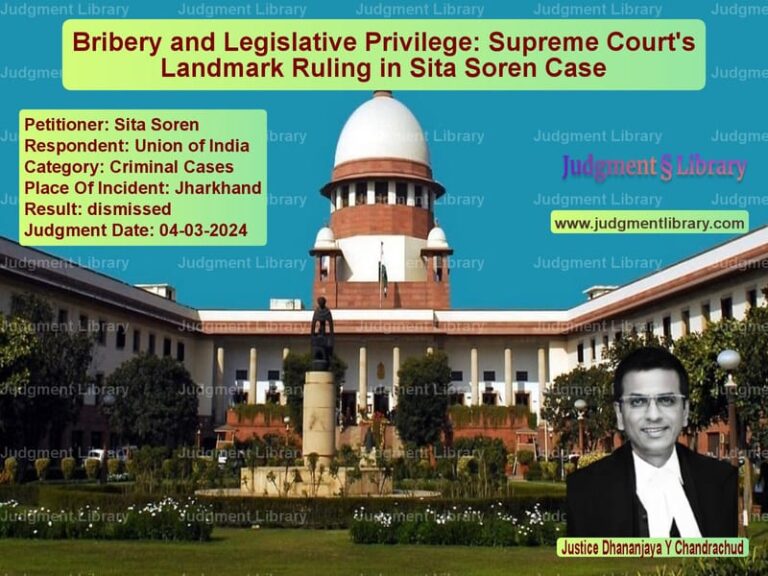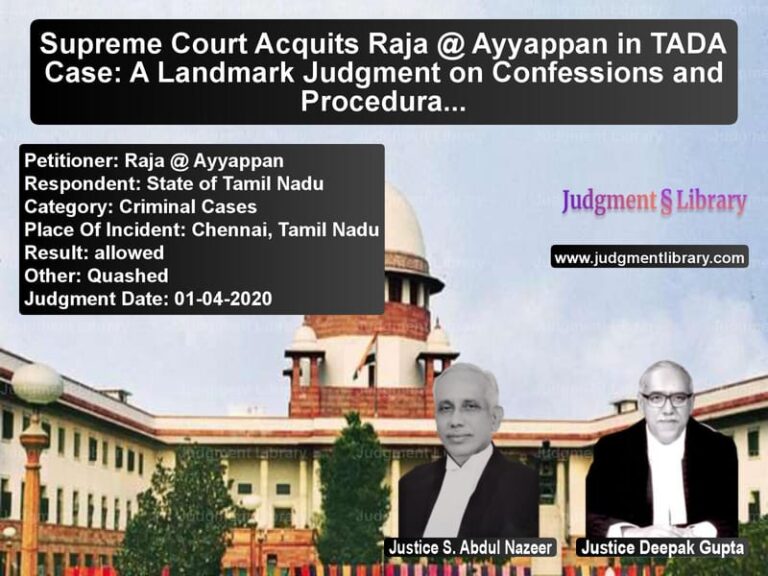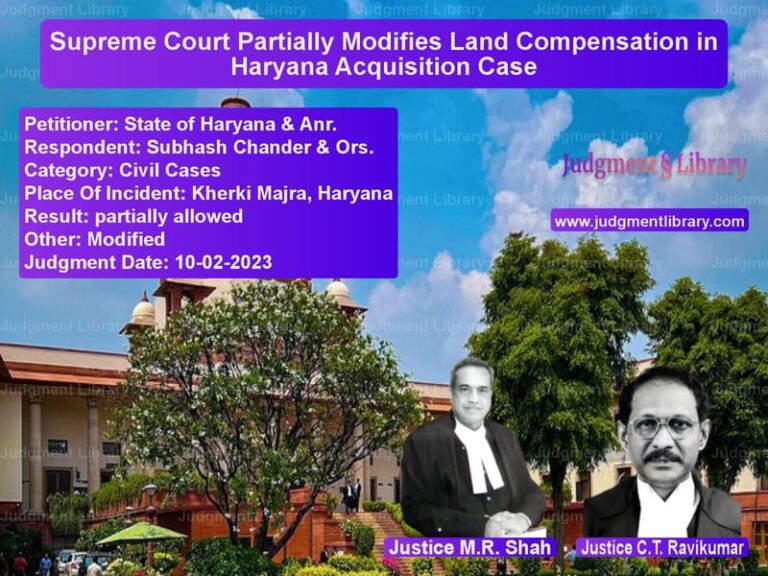Supreme Court Upholds Conviction in Uttar Pradesh Murder Case: Understanding Common Object in Unlawful Assembly
Introduction
The Supreme Court of India, in the case of Iqbal & Anr. v. State of Uttar Pradesh, dealt with a significant legal issue regarding criminal liability in cases involving unlawful assembly. The case centered around a brutal murder committed in the presence of multiple accused, raising questions about the application of Section 149 of the Indian Penal Code (IPC), which assigns vicarious liability to members of an unlawful assembly for crimes committed in furtherance of a common object.
The Court had to determine whether the accused, Iqbal and Virendra, who were convicted along with four others, were rightly held guilty under Section 302 read with Section 149 IPC. This case serves as an important precedent in clarifying how courts interpret common object and individual roles within an unlawful assembly.
Background of the Case
The case originated from a violent attack that occurred on the night of March 23-24, 1985, in Sahawar, District Etah, Uttar Pradesh. The complainant, Netrapal (PW-1), along with his father Sonpal (PW-3) and his uncle Raghuvar Dayal (PW-2), was sleeping outside their house when six armed individuals arrived and opened fire. Bhoop Singh, the complainant’s brother, was shot and succumbed to his injuries on the spot. The assailants then fled after hearing the cries of villagers.
The First Information Report (FIR) was registered the next morning, naming six individuals—Genda Lal, Ganpat, Sripal, Virendra, Ram Shankar Lodha, and Iqbal—as the perpetrators. The prosecution presented three eyewitnesses, including two injured witnesses, to establish the case.
Charges Against the Accused
The police, after investigation, filed a chargesheet under Sections 148, 302, 302/149, and 307/149 IPC, citing the following allegations:
- The accused formed an unlawful assembly with the intent to kill Bhoop Singh and other family members.
- They carried firearms and used them to shoot at the victims.
- The crime was committed as an act of revenge.
- Since multiple individuals acted together, their liability arose under Section 149 IPC, which deals with unlawful assemblies acting with a common object.
Trial Court’s Verdict
The prosecution examined six witnesses, including:
- PW-1 Netrapal (Complainant)
- PW-2 Raghuvar Dayal (Injured witness)
- PW-3 Sonpal (Injured witness)
- PW-4 Dr. O.P. Vaidya (Conducted Bhoop Singh’s post-mortem)
- PW-5 Investigating Officer
- PW-6 Head Constable
The trial court found all six accused guilty and sentenced them under Section 302 IPC read with Section 149 IPC for murder and Section 307 read with Section 149 IPC for attempt to murder.
High Court Appeal
All six accused appealed before the Allahabad High Court, but the court upheld their conviction. During the pendency of the appeal, four of the accused passed away, leaving only Iqbal and Virendra to contest their convictions.
Supreme Court Proceedings
Before the Supreme Court, the appellants contended that:
- There was no direct evidence to prove their role in the attack.
- They were merely present at the scene but did not participate in the firing.
- The prosecution witnesses were unreliable due to contradictions in their statements.
- The legal principle of common object under Section 149 IPC was not properly applied.
The Supreme Court had to decide whether the appellants shared a common object with the other accused and whether they could be held guilty under Section 149 IPC.
Supreme Court’s Observations
The Supreme Court examined multiple precedents on common object, including:
“It is not the intention of the legislature in enacting Section 149 to render every member of an unlawful assembly liable to punishment for every offence committed by one or more of its members. In order to attract Section 149, it must be shown that the incriminating act was done to accomplish the common object of the unlawful assembly.”
The Court held that the following factors proved the existence of a common object:
- All six accused were armed and entered the complainant’s home at midnight.
- They specifically inquired about Bhoop Singh before opening fire.
- Multiple gunshots were fired, suggesting a planned attack.
- Eyewitness testimony was consistent in confirming the role of all accused.
Key Judgment Excerpts
“Applying the ratio of Lalji’s case, it could safely be inferred that there was a common object to kill Chandrapal, Bhoop Singh and even others. The occurrence and presence of the accused persons have been proved to the hilt.”
Final Ruling
The Supreme Court upheld the conviction of the appellants, dismissing their appeal and affirming the findings of the lower courts. The Court reiterated that the presence of an accused in an unlawful assembly, armed with deadly weapons, is sufficient to establish guilt under Section 149 IPC.
Conclusion
This case highlights the importance of establishing common object in criminal trials involving multiple accused. The Supreme Court reaffirmed that individuals cannot escape liability by merely claiming they did not fire a weapon if they were part of a group with a shared intent to commit a crime. The judgment strengthens legal understanding of vicarious liability and the scope of unlawful assembly under the IPC.
Don’t miss out on the full details! Download the complete judgment in PDF format below and gain valuable insights instantly!
Download Judgment: Iqbal & Anr. vs State of Uttar Prade Supreme Court of India Judgment Dated 07-02-2017.pdf
Direct Downlaod Judgment: Direct downlaod this Judgment
See all petitions in Murder Cases
See all petitions in Attempt to Murder Cases
See all petitions in Judgment by A.K. Sikri
See all petitions in Judgment by Dhananjaya Y Chandrachud
See all petitions in dismissed
See all petitions in supreme court of India judgments February 2017
See all petitions in 2017 judgments
See all posts in Criminal Cases Category
See all allowed petitions in Criminal Cases Category
See all Dismissed petitions in Criminal Cases Category
See all partially allowed petitions in Criminal Cases Category

